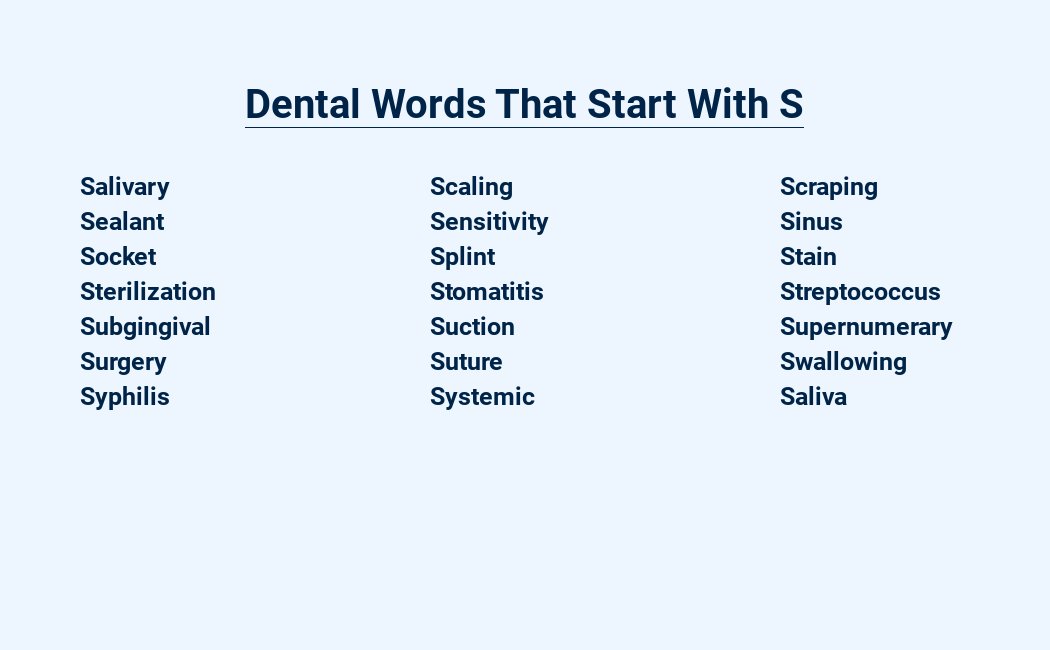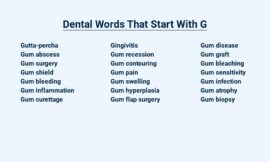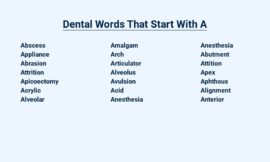Embark on a dental exploration starting with the letter “S”! From saliva, the foundation of oral health, toscaling and sedation, ensuring a comfortable dental experience.
Discover sensitivity, the key to understanding tooth discomfort, and delve into sinus lifts, providing a strong base for dental implants.
| Term | Definition |
|---|---|
| Saliva | A clear liquid produced by salivary glands in the mouth that helps to digest food, protect the teeth from decay, and keep the mouth moist. |
| Scaling | The removal of tartar and plaque from the teeth. |
| Sealant | A coating applied to the teeth to help prevent cavities. |
| Sensitivity | A condition in which the teeth are painful to hot, cold, or sweet foods. |
| Sinus Lift | A surgical procedure to raise the sinus floor in order to make room for dental implants. |
| Splint | A device that is worn in the mouth to protect the teeth from damage, such as clenching or grinding. |
| Staining | The discoloration of the teeth, which can be caused by a variety of factors, such as smoking, drinking coffee or tea, and eating certain foods. |
| Straightening | The process of correcting the alignment of the teeth, typically using braces or aligners. |
| Streptococcus | A type of bacteria that is found in the mouth and can cause cavities and gum disease. |
| Subgingival | A term used to describe something that is located below the gum line. |
Sealant: A thin, plastic coating applied to the chewing surfaces of teeth to prevent decay.
Scaling: The process of removing plaque and calculus from the teeth.
Sclerosis: A condition in which the teeth become hard and brittle.
Scurvy: A disease caused by a lack of vitamin C, which can lead to gum disease and tooth loss.
Sensitivity: A condition in which the teeth are sensitive to hot, cold, or sweet foods and drinks.
Septum: The wall of bone and cartilage that divides the nasal cavity into two halves.
Sinus: A hollow space in the skull, lined with mucous membrane, that is connected to the nasal cavity.
Socket: The hollow in the jawbone where a tooth is rooted.
Soft Tissue: The tissues of the mouth that are not hard, such as the gums, cheeks, and tongue.
Solder: A metal alloy used to join two pieces of metal together.
Space Maintainer: A device used to maintain the space in the jawbone for a permanent tooth to erupt.
Splint: A device used to immobilize a tooth or group of teeth.
Spoon Excavator: A spoon-shaped instrument used to remove decay from teeth.
Staining: The discoloration of teeth.
Stainless Steel Crown: A type of dental crown made of stainless steel.
Step-Down Bur: A type of bur used to create a step in a tooth.
Sterilization: The process of killing all microorganisms on an object.
Stimulator: A device used to stimulate the gums.
Stone: A hard material used to make dental casts and models.
Stop: A material used to prevent the flow of saliva or blood.
Strip Crown: A type of dental crown made of a thin strip of metal.
Subgingival Curettage: The process of removing plaque and calculus from below the gum line.
Suction: The process of removing saliva and other fluids from the mouth.
Sulcus: A groove or furrow, especially one between two teeth.
Supernumerary Tooth: A tooth that develops in addition to the normal number of teeth.
Suture: A stitch used to close a wound.
Syringe: A device used to inject or aspirate fluids.
Dental Words That Start with S
Saliva
Saliva, a vital fluid produced in the mouth, plays a crucial role in maintaining oral health.
It aids in digestion, protects teeth from decay, and lubricates the mouth, facilitating speech and swallowing.
Understanding the functions and composition of saliva is essential for promoting good oral hygiene and preventing dental problems.
Scaling
Scaling, a vital dental procedure, involves the removal of plaque and tartar buildup from tooth surfaces. Performed by a dentist or hygienist, it helps prevent gum disease, cavities, and other oral health issues.
Regular scaling maintains good oral health and a beautiful smile.
Sedation
Sedation: A state of reduced consciousness induced by medication, typically administered to patients undergoing dental procedures to alleviate anxiety and discomfort, allowing for a more relaxed and cooperative experience.
Sensitivity
Sensitivity in dentistry refers to a condition where teeth become hypersensitive to certain stimuli, such as hot, cold, or sweet foods and drinks.
This can cause discomfort and pain.
Sensitivity can be caused by various factors, including gum recession, worn tooth enamel, or a cracked tooth.
Treatment options depend on the underlying cause and may include desensitizing toothpaste, fluoride treatments, or restorative procedures.
Sinus Lift
A surgical procedure performed to create more space in the upper jaw for dental implants.
During the procedure, the sinus membrane is lifted, creating a space for the implant to be placed.
This procedure is typically recommended when the sinus cavity is too close to the jawbone, preventing the placement of an implant.
Snap-On Smile
Snap-On Smile is a revolutionary dental procedure that provides a beautiful, natural-looking smile without the need for extensive dental work.
It is a removable, custom-made appliance that fits comfortably over your existing teeth, instantly transforming your smile.
Sodium Fluoride
Sodium Fluoride: An essential component of fluoride toothpaste, mouthwashes, and some dental procedures. Proven effective in preventing cavities and strengthening tooth enamel.
Consumption should be monitored to prevent fluorosis.
Soft Tissue Laser
The soft tissue laser is a revolutionary tool in dentistry, offering precise and minimally invasive procedures. It enables dentists to perform treatments such as frenectomies, gingivectomies, and crown lengthening with greater accuracy and reduced discomfort for patients.
Space Maintainer
Space maintainers are dental appliances used to preserve space in a child’s mouth after losing a baby tooth prematurely. These devices prevent adjacent teeth from drifting into the empty space, ensuring proper alignment for the permanent tooth’s eruption.
Sphenoethmoidal Recess
Sphenoethmoidal recess is a small, air-filled space located at the back of the nasal cavity. It is bounded by the sphenoid and ethmoid bones and is continuous with the sphenoidal sinus.
The recess serves as a drainage pathway for mucus from the ethmoid sinuses.
Final Verdict
The realm of dentistry encompasses a vast array of terminology, with many terms commencing with the letter “S.” These terms encompass crucial concepts, procedures, and structures related to oral health. From the essential role of saliva in maintaining a healthy oral environment to the intricate techniques of sinus lifts and snap-on smiles, these terms collectively contribute to the comprehensive understanding and effective management of dental conditions.
Embracing this dental lexicon empowers individuals to actively engage in their oral health journey and make informed decisions alongside their dental professionals.




